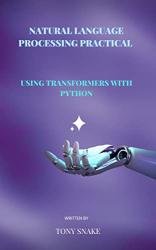 Название: Natural Language Processing Practical using Transformers with Python
Название: Natural Language Processing Practical using Transformers with PythonАвтор: Tony Snake
Издательство: Independently published
Год: December 9, 2022
Страниц: 275
Язык: английский
Формат: pdf, epub, mobi
Размер: 10.1 MB
Learn how you can perform named entity recognition using HuggingFace Transformers and spaCy libraries in Python. Named Entity Recognition (NER) is a typical natural language processing (NLP) task that automatically identifies and recognizes predefined entities in a given text. Entities like person names, organizations, dates and times, and locations are valuable information to extract from unstructured and unlabeled raw text. At the end of this tutorial, you will be able to perform named entity recognition on any given English text with HuggingFace Transformers and SpaCy in Python.
SpaCy is an open-source library in Python for advanced Natural Language Processing (NLP). It is built on the latest research and designed to be used in real-world products. We'll be using two NER models on SpaCy, namely the regular en_core_web_sm and the transformer en_core_web_trf. We'll also use spaCy's NER amazing visualizer. To get started, let's install the required libraries for this tutorial.
Fake News Detection in Python: Exploring the fake news dataset, performing data analysis such as word clouds and ngrams, and fine-tuning BERT transformer to build a fake news detector in Python using transformers library. Fake news is the intentional broadcasting of false or misleading claims as news, where the statements are purposely deceitful. Newspapers, tabloids, and magazines have been supplanted by digital news platforms, blogs, social media feeds, and a plethora of mobile news applications. News organizations benefitted from the increased use of social media and mobile platforms by providing subscribers with up-to-the-minute information. Consumers now have instant access to the latest news. These digital media platforms have increased in prominence due to their easy connectedness to the rest of the world and allow users to discuss and share ideas and debate topics such as democracy, education, health, research, and history. Fake news items on digital platforms are getting more popular and are used for profit, such as political and financial gain.
It is vital to recognize and differentiate between false and accurate news. One method is to have an expert decide, and fact checks every piece of information, but this takes time and needs expertise that cannot be shared. Secondly, we can use Machine Learning (ML) and Artificial Intelligence (AI) tools to automate the identification of fake news. Online news information includes various unstructured format data (such as documents, videos, and audio), but we will concentrate on text format news here. With the progress of Machine Learning and Natural Language Processing, we can now recognize the misleading and false character of an article or statement. Several studies and experiments are being conducted to detect fake news across all mediums.
Paraphrase Text using Transformers in Python: Explore different pre-trained transformer models in transformers library to paraphrase sentences in Python. Paraphrasing is the process of coming up with someone else's ideas in your own words. To paraphrase a text, you have to rewrite it without changing its meaning. In this tutorial, we will explore different pre-trained transformer models for automatically paraphrasing text using the Huggingface transformers library in Python.
It includes topics:
1. Named Entity Recognition
2. Fake News Detection in Python
3. Paraphrase Text using Transformers in Python
4. Text Generation
5. Speech Recognition
6. Machine Translation
7. Train BERT from Scratch
8. Conversational AI Chatbot
9. Fine Tune BERT
10. Perform Text Summarization
11. Sentiment Analysis
12. Translate Languages
13. Perform Text Classification
14. Build a Text Generator
15. Build a Spam Classifier
I have explained every topic in the most simplest way and you can use these topics in multiple place.
Who this book is for:
This book is highly appealing to all tech-savvy students, programming enthusiasts, IT graduates, and computer science professionals who want to build strong proficiency in building Python applications. Prior understanding of Python basic coding concepts like variables, expressions, and control structures is required to begin with this book. You can also read Basic Core Python.
Скачать Natural Language Processing Practical using Transformers with Python